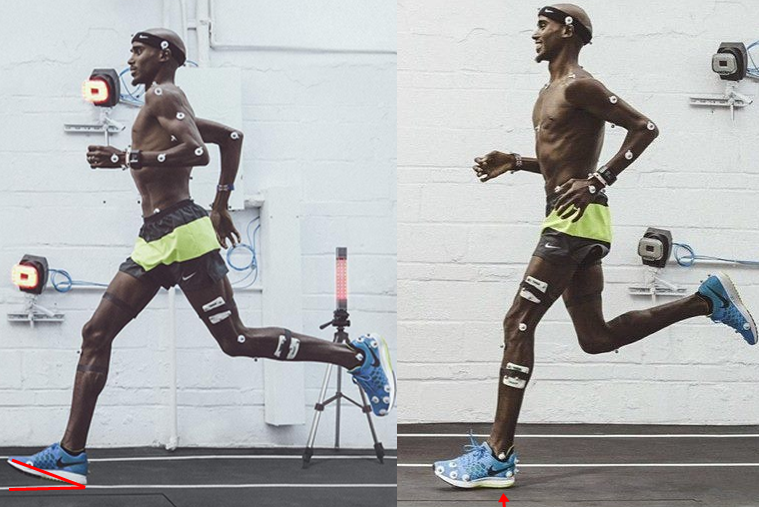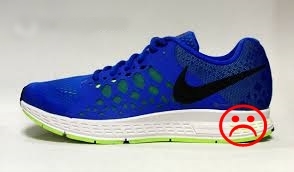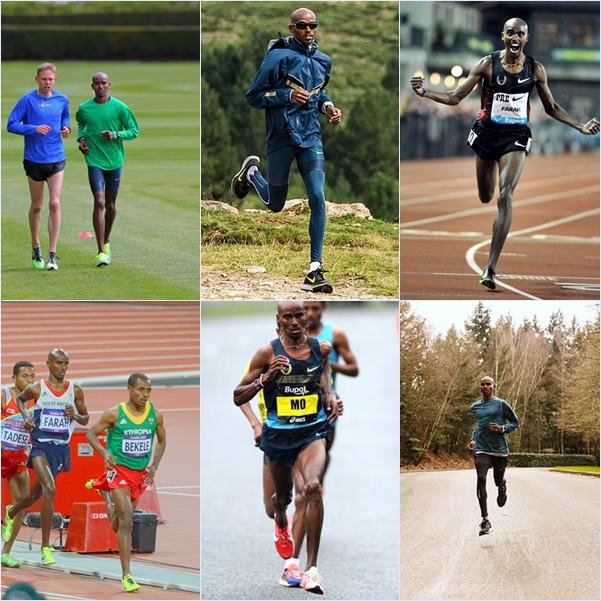Recently, Nike featured Mo Farah in an ad (shown below) for the Nike Air Zoom Pegasus 31. The first thing I noticed was a subtle change in Farah’s stride.

However, when Farah wears his ‘preferred’ footwear, which typically does not include a big, flared heel, his forefoot does not lift up upon foot strike and initial contact with the ground is made on his forefoot, not his heel.
How a Cushioned Heel Impairs Foot Strike Mechanics
In a running shoe with a raised heel, the foot is configured in a position where the heel is higher off the ground than the forefoot (heel-toe differential), and would be the same position of the foot if in a woman’s high-heeled shoe.

When running, as the leg swings out in front of the body to prepare for foot strike, the heel-toe differential causes the foot to be in a fixed dorsiflexion position (forefoot points up) which increases the likelihood of initial ground contact directly on the heel.
Heel striking in a heeled running shoe actually causes a runner to strike the ground with more force compared to a habitual barefoot runner:
Heel striking of course has implications to injury such as:
In contrast, most minimalist shoes are highly flexible and have a very minor, or an absent heel-toe differential which certainly helps lower heel strike potential.
Furthermore, previous research has demonstrated that aside from barefoot running, removing the flared heel of a running shoe would be an excellent first step in reducing heel strike potential.

Mo Farah does not heel strike, but the Nike Pegasus ad shows that he does. No matter how short, or long the distance is, Farah presents great forefoot strike running mechanics, which we can all learn from. However, the Nike Pegasus ad is precisely the kind of example of the potentially unfavorable impairments certain running shoes may have on biomechanics.
More From Run Forefoot:
Patellofemoral Pain Syndrome – Many runners suffer this dreaded injury, but many runners don’t know why. This article covers the main cause of knee injury in runners.
Achilles Heel – Found out why heel strike running is such a daunting task for the Achilles tendon, resulting in injury to the tendon.
Eccentric Exercises – We often hear about eccentric exercises, but you can achieve them just by running barefoot; find out how.
Forefoot Shoe Review – Read my review on the FeelMax Osma 2, an under-appreciated forefoot running shoes that is a great tool to help you mechanically run your best.
Strength Training – Instead of going to the gym, you’ll love these home gyms. They take-up minimal space and require only the motivation to workout!
Bretta Riches
BSc Neurobiology; MSc Biomechanics candidate, ultra minimalist runner & founder of RunForefoot. I was a heel striker, always injured. I was inspired by the great Tirunesh Dibaba to try forefoot running. Now, I'm injury free. This is why I launched Run Forefoot, to advocate the health & performance benefits of forefoot running and to raise awareness on the dangers of heel striking, because the world needs to know.
Latest posts by Bretta Riches (see all)
- Can You Run In Barefoot Shoes? Yes, But DON’T Heel Strike! - 21/07/2024
- Why Cushioned Running Shoes Are Really Bad for Your Feet - 19/07/2024
- Do Cushioned Running Shoes Cause Injuries? - 17/07/2024

Leave a Reply